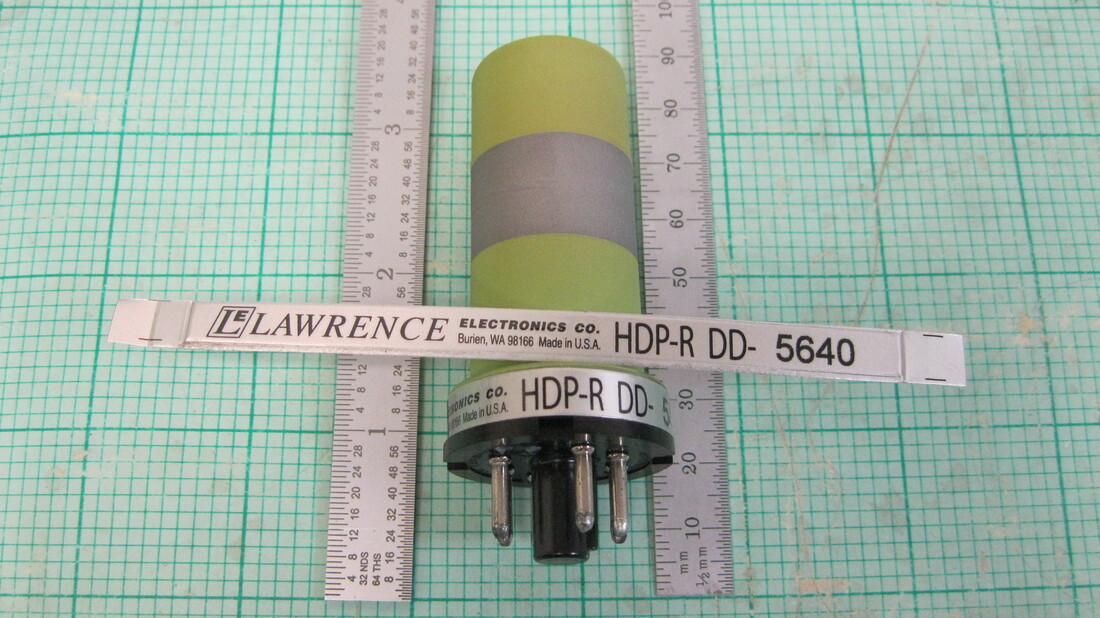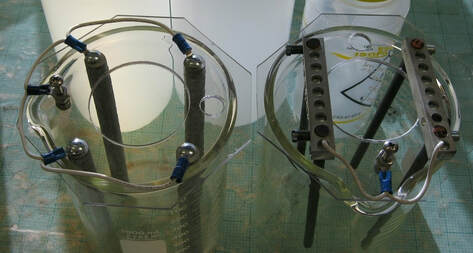Cadmium and Carbon Anodes in 1000 liter beakers

Gary Lawrenson, President
hydrogen2@lawrence-electronics.com
hydrogen2@lawrence-electronics.com
Save valuable maintenance time and avoid costly parts rework and downtime. Be sure your parts are safe and free of embrittlement failure.
To protect against deadly embrittlement of vital aircraft parts, it is essential to understand the two basic causes of embrittlement. Corrosion during service life of a part or during plating of metal parts. Parts subject to embrittlement are high strength metal parts such as landing gear, wing slats and engine mounts.
What is hydrogen embrittlement?
The hydrogen is generated by electro and electroless plating of the part or by corrosion on the surface of the part. All aircraft manufacturers require hydrogen embrittlement tests. Airbus and Boeing prefer gauge testing.
How plating causes hydrogen embrittlement?
When electro or electroless plating a part, hydrogen is co-deposited on the part's surface. Some of the hydrogen moves into the part. This hydrogen will move to high stress points and embrittle the part. To prevent this from happening, a post plating hydrogen relief bake is specified. The two aspects of plating hydrogen embrittlement control are:
1. Monitor the amount of hydrogen input during plating.
2. Monitor if the hydrogen can be removed in the bake-out time.
The Lawrence technology provides the only way to measure both parameters quickly.
How corrosion causes embrittlement
The corrosion of metal is a chemical reaction in which water H2O or gas comes in direct contact with metal… causing a “chemical” attack. As metal corrodes, Hydrogen is released… which can embrittle a part. Hydrogen "embrittles metal." This embrittlement makes it possible for the metal to physically "fracture" while supporting normal aircraft loads. lf this condition occurs and remains undetected, the results can be both costly and catastrophic. Remember: Corrosion is not always visually detectable, more often than not it only shows its ugly head after a part has failed!
Lawrence Gauges provide the following:
1. Embrittlement testing for one-third the cost of stress rupture testing.
2. Testing results in minutes not days
3. Monitors plating baths or solutions, providing corrective action information before failure.
4. Plating monitoring in fifteen minutes, no waiting 7 days for stress rupture test, reduces process time as well as inventory.
5. Testing of maintenance solutions prior to their use.
6. Immediate quantitative results.
7. Simplicity of operation.
8. Operator training provided at the Lawrence Laboratories.
9. Full one year warranty against defects in material or workmanship.
10. Testing required by ASTM F326. Boeing Process Specification DPS 9.28, MIL-STD-870C (QQ-P-416), MIL-STD-1500A, SAFRAN PCS-2100 (Messier-Bugatti-Dowty), Goodrich LGPS 1103, Leibherr LAT4-3001 & other Specifications. Boeing Plating Porosity Meter tests for BAC5804 & BAC5718.
The gauge monitoring process is fast and cost effective as compared to time consuming pass/fail procedures which do not give you quantitative results.
With the Lawrence Gauge you can go home each night knowing your maintenance procedures have protected your aircraft against hydrogen embrittlement.
The Lawrence Gauge. A small price for a peace of mind.
If you’re responsible for the safety and maintenance of your company’s aircraft fleet and would like more information on eliminating deadly embrittlement of vital parts, call or write Lawrence Electronics today.
Lawrence Electronics manufactures the Hydrogen Embrittlement Monitoring Gauge used in the world! We Calibrate and repair the Boeing Plating Porosity Meter (BPPM).
The Lawrence gauge is the standard of the industry. The gauge was first introduced in 1960, and is recognized by maintenance professionals and airframe manufacturers as “the state-of-the-art”.
Lawrence Equipment is used by companies and governments throughout the world.
Lawrence has sold hydrogen and corrosion monitoring equipment and systems to: Aerospatiale, Aero Vodochoy, Aerostar, Air Canada, Air France, Air India, Aircraft Accessories (Saudi Arabia), American Airlines, Blanc Aero, Boeing, Canadian Airlines Int’l Ltd., Cheng Du Aircraft Factory, China multiple sites, Construccion Aeronautica, Delta, England & Singapore, Embraer, Ethiopian Airlines, Hawker de Havilland, Heroux, Iberia Airlines, Jugoslovinski Aerotransport, JSC Gidroagregat (Russia), Korean Airlines, Liebherr, Lufthansa Airlines, Materials Research Lab., Messier-Hispano-Bugatti, Pakistan Int’l Airlines, Revima UTA Industries, Romanian Government, Scandinavian Airlines System, Safran, TAP Air Portugal, South African Airways, Thai Int’l Airways, Trans World Airways, Turkish Airlines, US Air Force, United Airlines, Varig Airlines. Email for specific references.
To protect against deadly embrittlement of vital aircraft parts, it is essential to understand the two basic causes of embrittlement. Corrosion during service life of a part or during plating of metal parts. Parts subject to embrittlement are high strength metal parts such as landing gear, wing slats and engine mounts.
What is hydrogen embrittlement?
The hydrogen is generated by electro and electroless plating of the part or by corrosion on the surface of the part. All aircraft manufacturers require hydrogen embrittlement tests. Airbus and Boeing prefer gauge testing.
How plating causes hydrogen embrittlement?
When electro or electroless plating a part, hydrogen is co-deposited on the part's surface. Some of the hydrogen moves into the part. This hydrogen will move to high stress points and embrittle the part. To prevent this from happening, a post plating hydrogen relief bake is specified. The two aspects of plating hydrogen embrittlement control are:
1. Monitor the amount of hydrogen input during plating.
2. Monitor if the hydrogen can be removed in the bake-out time.
The Lawrence technology provides the only way to measure both parameters quickly.
How corrosion causes embrittlement
The corrosion of metal is a chemical reaction in which water H2O or gas comes in direct contact with metal… causing a “chemical” attack. As metal corrodes, Hydrogen is released… which can embrittle a part. Hydrogen "embrittles metal." This embrittlement makes it possible for the metal to physically "fracture" while supporting normal aircraft loads. lf this condition occurs and remains undetected, the results can be both costly and catastrophic. Remember: Corrosion is not always visually detectable, more often than not it only shows its ugly head after a part has failed!
Lawrence Gauges provide the following:
1. Embrittlement testing for one-third the cost of stress rupture testing.
2. Testing results in minutes not days
3. Monitors plating baths or solutions, providing corrective action information before failure.
4. Plating monitoring in fifteen minutes, no waiting 7 days for stress rupture test, reduces process time as well as inventory.
5. Testing of maintenance solutions prior to their use.
6. Immediate quantitative results.
7. Simplicity of operation.
8. Operator training provided at the Lawrence Laboratories.
9. Full one year warranty against defects in material or workmanship.
10. Testing required by ASTM F326. Boeing Process Specification DPS 9.28, MIL-STD-870C (QQ-P-416), MIL-STD-1500A, SAFRAN PCS-2100 (Messier-Bugatti-Dowty), Goodrich LGPS 1103, Leibherr LAT4-3001 & other Specifications. Boeing Plating Porosity Meter tests for BAC5804 & BAC5718.
The gauge monitoring process is fast and cost effective as compared to time consuming pass/fail procedures which do not give you quantitative results.
With the Lawrence Gauge you can go home each night knowing your maintenance procedures have protected your aircraft against hydrogen embrittlement.
The Lawrence Gauge. A small price for a peace of mind.
If you’re responsible for the safety and maintenance of your company’s aircraft fleet and would like more information on eliminating deadly embrittlement of vital parts, call or write Lawrence Electronics today.
Lawrence Electronics manufactures the Hydrogen Embrittlement Monitoring Gauge used in the world! We Calibrate and repair the Boeing Plating Porosity Meter (BPPM).
The Lawrence gauge is the standard of the industry. The gauge was first introduced in 1960, and is recognized by maintenance professionals and airframe manufacturers as “the state-of-the-art”.
Lawrence Equipment is used by companies and governments throughout the world.
Lawrence has sold hydrogen and corrosion monitoring equipment and systems to: Aerospatiale, Aero Vodochoy, Aerostar, Air Canada, Air France, Air India, Aircraft Accessories (Saudi Arabia), American Airlines, Blanc Aero, Boeing, Canadian Airlines Int’l Ltd., Cheng Du Aircraft Factory, China multiple sites, Construccion Aeronautica, Delta, England & Singapore, Embraer, Ethiopian Airlines, Hawker de Havilland, Heroux, Iberia Airlines, Jugoslovinski Aerotransport, JSC Gidroagregat (Russia), Korean Airlines, Liebherr, Lufthansa Airlines, Materials Research Lab., Messier-Hispano-Bugatti, Pakistan Int’l Airlines, Revima UTA Industries, Romanian Government, Scandinavian Airlines System, Safran, TAP Air Portugal, South African Airways, Thai Int’l Airways, Trans World Airways, Turkish Airlines, US Air Force, United Airlines, Varig Airlines. Email for specific references.


